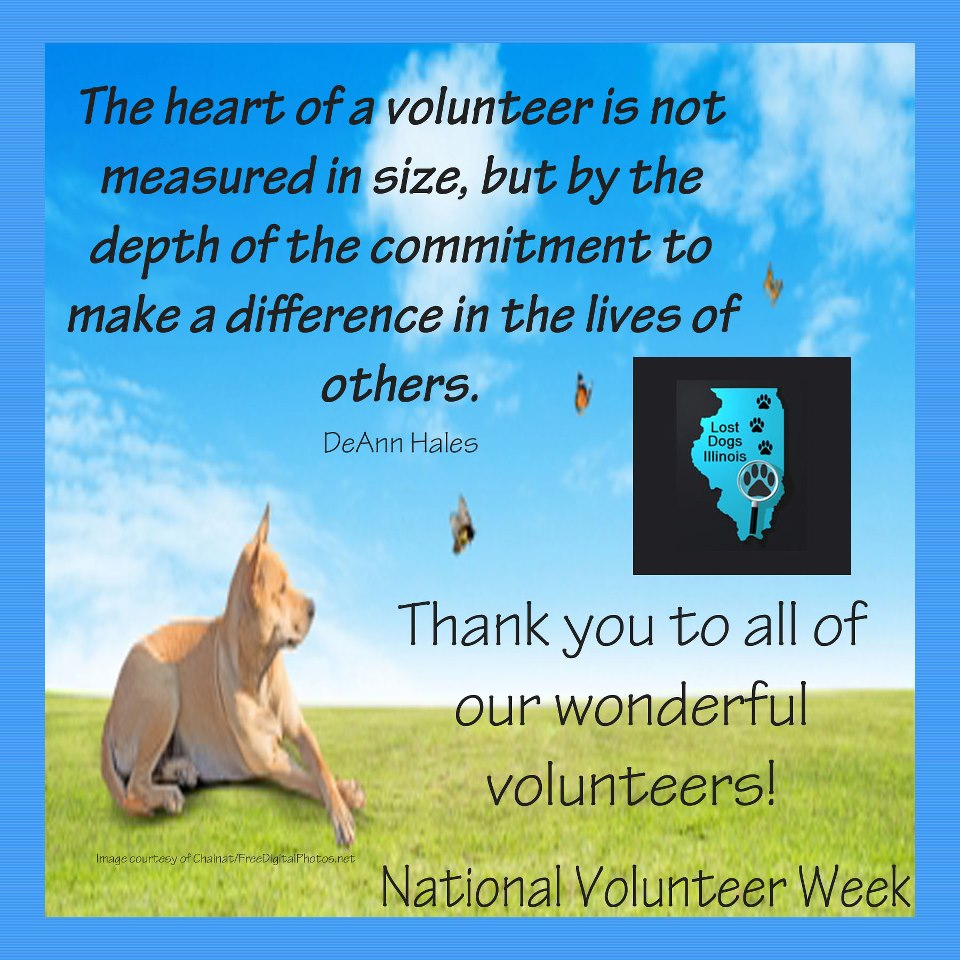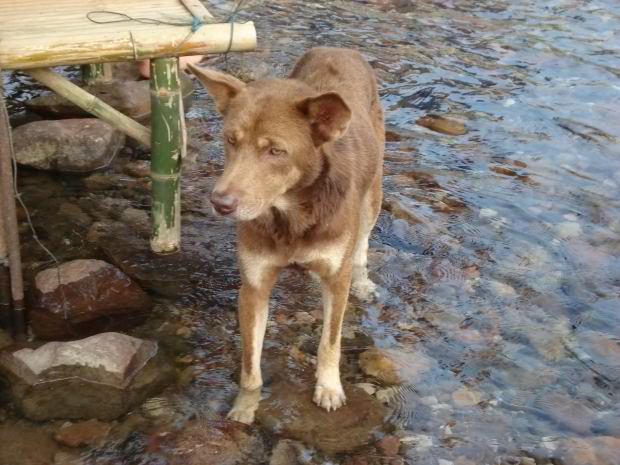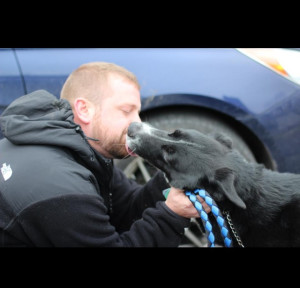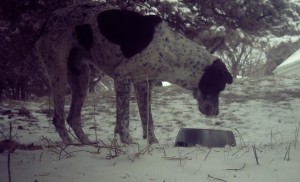We want to thank our dedicated and compassionate volunteers who monitor our FB page; post lost/found dogs & reunions, maintain our website; follow up on lost/found dogs; monitor Craigslist, attend special events, provide IT and Twitter support, provide statistics, write articles and photo tips, and the list goes on. Without them this page and the website wouldn’t be possible. Thank You LDI Volunteers!
Jump Starting Your Search For the Long-Lost Dog
Your lost dog has been missing now for several weeks (or months) and your sightings and leads have fizzled out. Don’t despair. It is never too late to jump-start the search for a long-lost dog.
This article is designed to give you some ideas for reigniting your search to give you a place to pick up again. Hopefully, you have read our other articles on shy lost dog search strategies and friendly lost dog search strategies. If not, please check the categories at the right that link to many more articles. We also hope you have mapped all the sightings on a map, either a web-based map like Google Maps or a large-scale paper map.
Now, imagine you are a detective working on a cold case. You may talk to 99 people who have not seen or heard anything. You are looking for the ONE person who has. Someone, somewhere has seen or knows something. Be persistent and don’t give up. Even if they haven’t seen your dog, they may see your dog tomorrow. Putting a flyer in their hands ensures they will know who to call when they see him.
Look at your map and draw a circle in a one mile radius around the last confirmed sighting. Go back to the last confirmed place that your dog was seen and flyer heavily in a one mile radius. Don’t let false assumptions or geographic barriers deter you. Don’t assume that your dog would NEVER have crossed the highway or the river or the lake. False assumptions will make you miss possible sightings and leads.
Make sure you have listed your dog with our partner, Pet FBI at www.petfbit.org so that his or information is maintained in a centralized, national database. Talk to everybody! Put a flyer in their hands and ask them if they have seen your dog or if they think a dog may have been hanging around their house or farm. Did they see dog tracks under their bird feeder? Was their dog poop in their yard when it shouldn’t be there? Was their outdoor cat food disappearing faster than normal?
Visit EVERY place that serves food in the one mile radius. Don’t forget convenience stores and gas stations! Talk with the kitchen staff and management. Did anybody see a dog hanging out near the dumpsters? Did anybody notice dog tracks near the dumpsters in the winter? Did any restaurant patrons mention a dog hanging out in the parking lot? Did anybody see a similar looking dog being walked in their neighborhood?
Think about the demographics of the neighborhoods in the one mile radius. Maybe you need to print some flyers in Spanish or another language? Or, maybe there are some older residents who don’t get out much to see signs and flyers but may have taken pity on your dog and fed him over the winter? Think about the people that may not have seen or understood your first round of flyering.
Now is a great time to refresh your posters and intersection signs. You may want to change the heading to STILL MISSING – so that people know that the search is still on. Think outside the box. Ask every business in the one mile radius if you can hang a flyer in their window and employee break room. Maybe your dog approached workers on their lunch break. Or maybe they saw him when they were driving to or from work.
If you don’t get any new leads in the one mile radius; you will need to expand your area. You may want to consider using USPS Every Door Direct Mail. Beware of some of the other lost pet mailing services that you will see advertised. Some of them are scams and do not reach the number of homes that they promise.
Refresh the memories of the animal control facilities, shelters, police departments, vet clinics and municipal offices in your county and surrounding counties. Send them fresh flyers.
Give a new flyer to postal workers, delivery drivers, school bus drivers and garbage truck drivers. Don’t forget pizza and sandwich delivery drivers also! They are out and about in the evening, when your dog may be moving around, looking for food.
Check with your local Department of Transportation. Have they found any deceased dogs alongside the road? Or has a dog been spotted eating on a deer or other wildlife carcass?
Check with your local railroad companies to see if they have any reports of deceased dogs along the railroad tracks. Lost dogs often use railroad tracks as a path of travel between their hiding places and food sources. Deceased wildlife hit by trains also make a good food source for hungry lost dogs.
Repost your dog on Craigslist, Next-door and your local online classifieds. Consider taking out a print newspaper ad also. There are still many people without computers or the internet!
Remember, Never Give Up! Re-energize and jump start the search for your missing dog. Your dog is depending on you to bring him home.
Our tips, ideas and articles are based on information gathered from thousands of successful lost dog recoveries. Any advice or suggestions made by Lost Dogs of Wisconsin/Lost Dogs Illinois is not paid-for professional advice and should be taken at owner’s discretion.
1/22/2021
We Don’t Recommend Offering a Reward for Your Missing Dog
Are rewards a good idea? Many lost dog articles in print and on the internet recommend offering a reward to increase the chance of getting your dog back. We don’t agree. We have based our opinion on thousands of successful recoveries. In this article we would like to explain our reasoning based on the three possible scenarios for your missing dog:
1.If your dog is shy; offering a reward does exactly what we DON’T want people to do. It encourages people to chase your dog in order to get the reward. We have an eyewitness account of a woman chasing an extremely shy dog across a corn field with a ham sandwich because she wanted the reward money. It could easily have had tragic consequences because she was chasing him directly towards a busy highway. Luckily the dog was recovered safely, but it took two more weeks and the dog had gone an additional twenty miles. This added extra expense and stress for the already stressed-out owners.
Your strategy with a shy dog should be to encourage the dog to “settle” into an area and relax. Regular meals at a feeding station will allow the dog to return to a more domesticated state of mind and will give you the best opportunity to capture him.
2. If your lost dog has been picked up by a Good Samaritan, their motive will be to return the dog to a loving home. Even if they have already kept or rehomed your dog, they will feel guilty or be afraid they will be “ratted out” by their neighbors. You can always offer them a small token of your appreciation for their time and trouble after you have your dog back safely.
Your strategy should be to file a police report immediately so that you have started the paper trail that may be necessary if your dog has been kept or rehomed. You will also need to flyer very heavily and use intersection signs. Put a sign in front of your own house also! Keep checking your local shelters. Remember, the Good Samaritan is motivated to return your dog by seeing how much you miss him.
3. If your dog has been trulystolen (somebody broke into your car, residence or business with the intent of stealing your dog and/or other possessions) and you feel that their motive is greed; you still don’t need to put a reward on the flyer. The thieves will be watching for your flyers and ads and will contact you to ask for a reward. Make sure you have contacted the police and have them accompany you when you arrange to meet the thieves.
Offering a reward for a missing dog has these other detrimental effects:
1. It encourages scammers to contact you, who do not have your dog and may never even have seen your dog. But they have seen your flyers and ads offering a reward. They might email you pictures that look like your dog; these may be photo shopped, or taken from your Facebook page. The scammers will want to meet you at a location to exchange cash for your dog. Call the police immediately if you are approached by somebody that says they have your dog but you must give them money to get your dog back. Otherwise you will have no money and no dog.
2. It makes it harder for the next person who loses their dog, especially if they can’t afford to offer a reward. Rewards encourage scammers, thieves and dognapping.
3. It “legitimizes” dognapping and encourages people to hold out for a reward, perhaps even Good Samaritans. Stealing a dog or keeping a dog that you have found is illegal. Extortion is illegal. We need to keep emphasizing this in order for it to be taken seriously by law enforcement and the public.
The buck stops with you! Please don’t publicize a reward for your missing dog on your flyers and ads. Let’s all work together to help more lost dogs get home safely.
Our tips, ideas and articles are based on information gathered from thousands of successful lost dog recoveries. Any advice or suggestions made by Lost Dogs of Wisconsin/Lost Dogs Illinois is not paid-for professional advice and should be taken at owner’s discretion.
Using Facebook to Maximum Potential
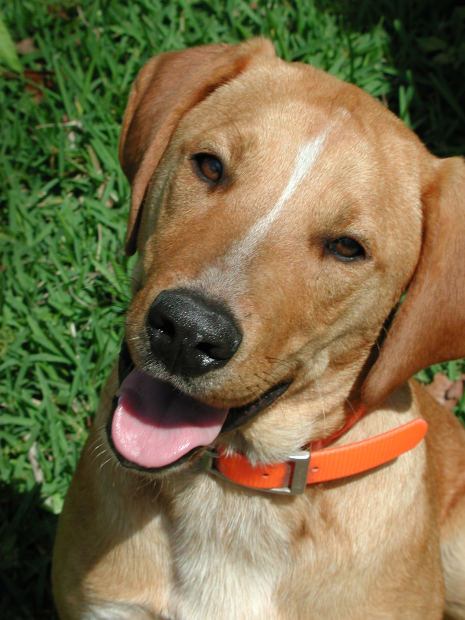
Lost Dogs Illinois was designed to help individual owners and finders of dogs who are keeping them in their homes while looking for the dog’s owner. We provide postings, a website, tips and suggestions to help happy reunions happen. We are thrilled that the idea has taken off and has become so successful. We are often asked if we can post pictures of “strays” in shelters, veterinarian clinics, police departments or other animal control or stray holding facilities. We would love to accommodate them all; but unfortunately this would defeat our purpose. When we “overpost” Facebook has a sneaky way of hiding our posts in our fan’s newsfeeds. This would also overwhelm our volunteers who generously give of their time to help lost dogs.
Instead, we encourage every shelter, vet clinic, police department or other agency that holds “strays” to develop their own Facebook page to help lost pets in their community. We will gladly share the link to the page and feature it on our website. We truly believe that with today’s technology and social media availability that it is the ethical responsibility of every animal control and stray holding facility in America to make sure that they are using all of the tools available to get lost pets back to their owners. Reuniting lost pets frees up kennel space for the truly needy animals and saves lives.
Why Are We All A-Twitter?
 Facebook is great! It has helped us to connect and share our posts with over 32,000 Facebook fans in Illinois. Many of those fans re-share our posts and many lost dogs have been reunited with their owners. But not everybody is on Facebook. That is why we have branched out to include other social media sites in our toolbox. Pinterest is a hot new social media site that we are on. Or, if you like your messages short, sweet and easily searchable; you can “follow” us on Twitter.
Facebook is great! It has helped us to connect and share our posts with over 32,000 Facebook fans in Illinois. Many of those fans re-share our posts and many lost dogs have been reunited with their owners. But not everybody is on Facebook. That is why we have branched out to include other social media sites in our toolbox. Pinterest is a hot new social media site that we are on. Or, if you like your messages short, sweet and easily searchable; you can “follow” us on Twitter.
For efficiency, we have linked our Facebook account to our Twitter account so that our Facebook postings automatically are “tweeted”. But Twitter requires that we keep our “tweets” to only 140 characters. So, we try to get all of the important information out about lost or found dogs in the briefest way possible. Then, if somebody sees a tweeted lost or found dog from their area, they can click on the link for more information. Or, if the dog isn’t from their area, they can ignore it. Twitter also gives the account user the ability to “retweet” the posting to their followers. One retweet from an influential user (think celebrity or a media outlet like a newspaper or radio station) can result in our tweet going to thousands of people.
Did you know that you can search Twitter via hashtags? A hashtag is a word or phrase prefixed with the symbol #. For instance if you want to see all of the dogs missing from the Springfield area – you can simply type #Springfield into the search box. You will get our missing or found dogs but will also get all of the other news and information about Springfield. Be aware, that there are other cities in America named Springfield, so you might get search results from those also. If you want to see all of our missing and found dogs, regardless of location, you can follow our Twitterfeed at @LostDogsIL.
A note about hashtags: They must be all one word to work. Buffalo Grove must be typed #BuffaloGrove. Capitalization isn’t important. #buffalogrove would get you the same results in the Twitter search. So, when you see our Facebook posts without spaces between the words and the # symbol in front, it isn’t because we can’t spell! It’s because we are trying to maximize our exposure so that more lost dogs get home!
Thank you for “sharing”, “pinning” and “retweeting” our postings. You are saving lives!
Creating and Placing Effective Signs
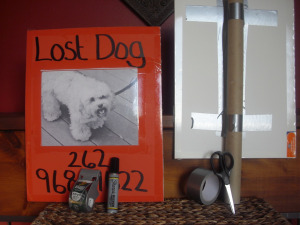 Posting signs is one of the most effective things you can do to get your lost dog back home. But it’s important to realize that not all signs are created equally, meaning some are more effective than others. If you follow the steps below, you will be successful at both creating effective signs and putting them in the appropriate locations.
Posting signs is one of the most effective things you can do to get your lost dog back home. But it’s important to realize that not all signs are created equally, meaning some are more effective than others. If you follow the steps below, you will be successful at both creating effective signs and putting them in the appropriate locations.
- Purchase the following supplies if you don’t already have them: seven colored foam poster boards that are at least 15” x 20”, rolls of clear and silver duct tape, a large Sharpie and scissors.
- Print one 8 ½” x 11” picture of your dog for each poster board.
- Write, “LOST DOG,” at the top of each poster board with your Sharpie.
- Tape a picture of your dog in the center of each poster board using clear duct tape, making sure to cover each picture entirely with clear duct tape or putting the picture into a ziploc gallon bag (w/opening at the bottom) to protect them from wet weather.
- Write a contact number below your dog’s picture.
- Waterproof your signs by covering their foam edges with clear duct tape.
- Put a sign in your yard so it can be seen easily by passers-by.
- Map a 3-mile area around the location where your dog went missing in the form of a hexagon.
- Secure signs at the intersections nearest to each point of the hexagon using your silver duct tape and scissors.
- Move your signs after each reported sighting of your dog by mapping a new 3-mile wide hexagon around the spot where your dog was most recently seen, and hanging signs at the intersections closest to each of the hexagon’s points.
- Last but not least, always make sure you have permission from the land owner before placing a sign, including city and county property.
Flyer, flyer and flyer some more!
Your friends and family members are eager to help you find your lost dog. They are willing to do whatever it takes to bring him/her home, including combing through every street and back alley in your neighborhood. They are all waiting for instruction from you. But, what should you tell them to do? What is the best way to use their time and effort to find your missing dog?

Friends want to help? Send them out flyering
Even though it may seem counter intuitive, you should not send your friends and family members on a wild goose chase, or, in this case a dog chase, through the streets. Looking for a lost dog by wandering through the streets is like looking for a needle in a haystack. And, a dog who is approached by someone the animal doesn’t know well may get scared and run even farther from home…even if all the person was trying to do was return the dog to its family.
What you should say to your friends and family members is that you’d appreciate them taking some time to put out flyers all over town. Hand each of them a stack of flyers that include a full, current picture of your dog, a description of his or her appearance that highlights any unusual physical or behavioral traits the dog has, and your contact information.
When your friends and family members look at you like you’re crazy, remind them that the most effective way to find a lost dog is by putting up and handing out flyers as soon as possible following an animal’s disappearance. More often than not, a dog is reunited with its family because someone who has reviewed a flyer sees the lost pet, and calls the dog’s distraught owners.
So, if your pet goes missing at some point in the future, gather as many friends and family members as you can, and send each and every one of them out with big stacks of flyers. It is the best way to ensure your lost dog will be returned to your loving arms.
Payton – Waiting For Rick
We’d like to share an inspiring story about Payton, German Shepherd-Black Lab mix owned by Rick from Glendale Heights, who went missing recently from a family member’s home in New Lenox. Payton was supposed to spend a few days with Rick’s cousin, but being the shy boy he is, didn’t even want to get out of the car that morning….until the doors were left open for him…and then he saw his chance to bolt! Neighbors, Animal Control and the Police Dept. were notified immediately and, though there were a few sightings (so they knew he had stayed in the area) friends and family driving around all day looking for him just could not find him. Everyone felt he was looking for Rick, who was out of town!
Flyers were put up all over the next day, and Payton’s info was shared on several sites, including Lost Dogs Illinois. Upbeat attitudes faltered as there were no sightings this day. A paid call-search site was contacted and calls went out to surrounding neighbors the next morning. Rick’s fiancee, Cassandra, began getting calls of sightings, but whenever she went out, Payton was nowhere to be seen.
Following guidance from Will County Animal Control, LDI, etc., clothing with Rick’s scent was put out, along with food, and a humane trap. Cassandra even kept some of Rick’s clothing dangling from her car as she drove around in her search! Another fruitless day went by…..
On the fourth day of Payton’s disappearance, with Rick back at home, he, Cassandra, neighbors and friends, (especially Phil and Robin and Laurie from Will Cty AC who spent time on her days off), after passing out more flyers and business cards, searching, and taking more calls of sightings FINALLY saw Payton for themselves as he crossed Rt 80. Rick screamed for him as Payton re-crossed the busy highway back toward him. Though they were hopeful, Payton still managed to elude them all.
Animal Control was ready the next day with tranquilizer darts, as Payton was again spotted at the edge of the woods. Everyone thought this drastic measure would be necessary as Payton, timid by nature, had to be terrified after 5 days out on his own!. Payton stayed put, as Rick walked toward him. If he were to come to anyone, it would be to Rick, who had had him for 6 years, since he was a puppy. Payton turned back toward the woods. Rick called his name, and Payton turned around and stared at him, as if in a showdown…..at that moment, frozen in time, Rick remembered a tip he had gotten from Lost Dogs Illinois, that advised him to lower himself to the ground. He laid down flat, always keeping Payton in his line of sight…..and Payton came closer and closer till he jumped on Rick and began licking his face. The reunion everyone had prayed for was accomplished! Missing 2/7/13, Home At Last 2/12/13. Welcome Home, Payton!
By Barb Scalzitti
Lost Dogs Illinois would like to thank Rick and Cassandra for allowing us to share this special story of Payton’s escape and eventual return with all our fans. We hope that those of you reading this will use the tips and resources available on our site and through their local ACO’s and communities if the need arises.
Please note: Chemical capture (commonly called tranquilizer guns) is typically handled by trained animal control officers. There are serious dangers involved with using this type of capture. Be sure to ask the officer about these dangers and then carefully weigh the benefits vs. the risks.
Harnessing the Energy – Part 5 (Common Pitfalls)
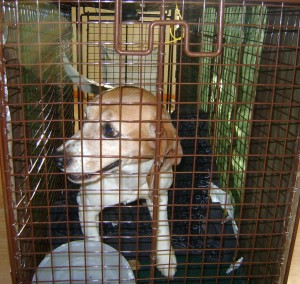
Lindsay, a shy beagle was successfully captured by the well-coordinated team of volunteers at Midwest BREW.
In this final segment of our series for shelters and rescues, we will focus on some of the common mistakes that can lead to a prolonged search or unfortunately even the death of the missing dog. Most of these mistakes can be attributed to a lack of leadership or the absence of a strong point person on the case. We covered this in detail in Part 3 of the series. Without strong leadership, the volunteer base will become frustrated and frayed. Some may become disinterested, some may give up, and some may go off on their own, using methods that we would never recommend. These include:
- Pitfall #1 – Volunteers physically searching for a dog. Most missing rescue dogs are shy. Foot searches are never recommended unless the dog is a very young puppy (barely walking) or has been severely injured, such as being hit by a car. In these situations a “grid search” might be warranted. But this must be well-coordinated with a good plan and strong leadership. Foot searches almost always result in driving the dog further away. He will sense that he is being pursued. If he keeps getting driven out of the flyering area – there will be a lack of sightings and the volunteers will lose the motivation to flyer larger and larger areas. You may also drive the dog into hiding, causing a lack of sightings which also causes frustration and makes volunteers lose hope. Worst of all, your volunteers may pressure the dog and cause him to bolt into traffic and be injured or killed.
- Pitfall #2 – Using a psychic, animal communicator or douser. These are almost always a scam. Or well-meaning people who think they have a connection with animals but know very little about lost dog behavior. They will appear to be “psychic” but they are usually studying google maps and satellite photos to talk about landmarks, even though they live far away. Some may do the first reading for free, but then ask for a credit card number for subsequent “readings”. They advertise on Craigslist and they may contact you offering their services. The readings will be vague. “I see your dog with an older couple.” “I see your dog in a yellow house.” Getting the word out through the use of flyers and signs brings lost dogs home. Psychics can send you in the wrong direction or worst of all tell you that your dog has “passed”. Don’t give up unless you find the remains of the missing dog. He is out there somewhere and perseverance, common sense and logic will bring him home.
- Pitfall #3 – Tracking dogs. There are some legitimate tracking dog services. They are few and far between. Screen them carefully. What is their success rate at tracking a shy lost dog? If their success rate sounds too good to be true, it is. They are a scam. Remember that good tracking dogs may be able to locate a scent, but lost dogs can move quickly. There are dozens of “pet detectives” that are currently preying on unsuspecting, distraught lost dog owners. They are using Craigslist and Facebook to advertise for free and will tell you that they can find your dog. Remember, you will still have to flyer, establish a feeding routine and trap the dogs. Instead, use your rescue’s valuable resources for flyering, signs and advertising.
- Pitfall #4 – Giving out exact sighting or trap locations – You will need to communicate with your volunteers, preferably through some sort of closed email or Facebook group. But make sure that they understand that what you share is confidential. You NEVER want to disclose a sighting or trap location publicly – on a Facebook page, in a blog, or to the media. Keep the location confidential because wanna-be heroes, reward seekers, and curious people can derail your plans very fast. Then you will be picking up and starting all over again and you will risk volunteer burnout.
- Pitfall #5 – Allowing too many volunteers to man a feeding station or trap. Remember, your lost dog is probably very shy and doesn’t trust many people. You need him to relax and feel comfortable coming to a feeding station so that you can eventually trap him. If everytime he goes to the location, there are different scents from different people, he may abandon that location completely and move on. Ideally, the person most bonded with the dog should be the one that is refreshing the feeding station and manning the trap. One or two helpers may need to be involved, but a revolving schedule of volunteers is counter-productive.
We hope this series has given you some guidance and ideas if one of your rescue or shelter’s foster or adopted dogs go missing. Searching for a shy lost dog is expensive and time-consuming. Pre-planning, volunteer training and avoiding common pitfalls will save you the time, money and resources that could be better spent on saving more lives.
Previous article – https://www.lostdogsillinois.org/harnessing-the-energy-part-4/
Harnessing the Energy – Part 4
Your team of volunteers has worked hard at flyering and posting signs and now you’re getting some sightings! This article will cover what we have found to be the best method for handling these.
The point person should keep a sighting journal. It is hard to remember all of the details from a phone call. Something that may seem insignificant at first may become very significant as time goes on. So most importantly, get the name and phone number of the caller, so that you can call back with any extra questions!
Ask the right questions and make detailed notes.
1. Where did you see the dog? Ask them to please be specific. For example: the dog was going north on Ash street toward the Bay City Mall. On the other side of the street was Walmart.
2. When did you see the dog? What was the weather like? Again, ask for specifics. Example: The dog was seen at 10 a.m. on Monday, August 5th. It was raining at the time.
3. Can you describe the dog? Was he wearing a collar? What color was the collar? Did he seem okay?
4. What was he doing? Was he trotting, running, darting in and out of traffic, sleeping, playing with other dogs, walking calmly, etc?
5. How was he carrying his body and tail? Was he low to the ground, almost crawling? Was his tail up or down or waggin?
Record all of these details in your journal and then post the sightings to a map. You can use an old-fashioned paper map or you can use an interactive google or Mapquest map that you can share with your volunteers. We recommend that you NEVER share this or any sighting information with the public.
The number one cause of death of lost dogs is that they panic and run into traffic and are killed by a car. When you post sighting locations – you are encouraging reward seekers, wanna be heroes, and overzealous people from rushing to the location and frightening the dog.
Remember, the whole goal now is to let the scared lost dog settle in the area. Then you can implement a plan to catch him (trapping, luring, etc.). But if you are constantly pressuring the dog, he will keep moving, and you will always be behind him. You will have to keep flyering more and more areas and this will be draining on your volunteers. Remember that most of your volunteers have full time jobs, and their own families and dogs to look after. You will need to respect their time and maximize their efforts.
Make sure that your volunteers understand that the goal is to allow the dog to settle in an area. They must change their mindset from “searching” to “luring”. You wouldn’t try to chase and catch a feral cat. You start feeding a cat in one location and then you trap them. You will use this same approach for a scared, missing dog.
After you get off the phone with the caller, immediately gather the necessary supplies and head to the location. The person most bonded to the dog (if it isn’t you) should also go. But you do not want a large group. You will need:
- smelly treats (think hotdogs, liverwurst, canned cat food)
- water and bowls
- slip lead, regular leash and collar
- flyers
- trail camera (or fireplace ashes or cornstarch)
When you arrive at the sighting location:
- Don’t slam the car door!
- Stay calm – the dog will feel your nervous energy and may take off again. He could be in hiding watching you.
- If you see the dog (possible but not probable):
- The person who is most bonded with the dog should sit or lie down by themselves and scatter tasty treats around themselves and WAIT. It may take minutes or hours for the dog to creep slowly towards them. The dog may circle around and approach from behind. Put your phone on silent and don’t talk on it. Everybody else should leave the area.
If you do not see the dog:
Don’t waste time driving around.
Immediately go door to door and flyer – speaking with everyone. Call in more volunteers to help with this.
If no one is home – leave a flyer that you have handwritten on: SEEN! 4 p.m. May 31 at the edge of your property or corner of this block or across from the Walgreens. Be specific so the home owner knows to keep a look out. Make sure your flyers clearly state the nobody should call or chase the dog. Just call with sightings.
Before leaving the sighting area:
Leave food and water! Anything except dry kibble (which doesn’t have an odor). Again, think smelly, scrumptious food. If you have a trail camera set it up facing the food so that you can see if the dog is approaching and eating when you aren’t there. . If you don’t have a trail camera, sprinkle fireplace ashes or cornstarch around the bowls so that you can examine the area for tracks when you return.
Remember, when the lost dog’s needs are being met:
He will start to let down his guard.
He will start to trust people and return to a domesticated state of mind.
Your chances of safely capturing him are greatly increased.
Don’t be too quick to dismiss a sighting. Most sightings are legitimate. People describe dogs differently so don’t dismiss a sighting because the description does not match exactly. Remember, that the public may not know dog breeds or sizes like you do. They may call an American Eskimo Dog a Samoyed. Or a shepherd mix a husky. Assume that every sighting is legitimate, unless absolutely proven otherwise, and mark it on the map. Dogs can travel great distances very fast, especially if they have been pursued. They may be using shortcuts that you aren’t aware of. Don’t assume that a sighting is too far away to be your dog. You will be able to use your map to give you clues to your dog’s paths and patterns.
Next, we will discuss common pitfalls and mistakes that are often made when a rescue is searching for one of their foster or newly adopted dogs. We will try to give you some advice to avoid these pitfalls.
See part 5 https://www.lostdogsillinois.org/harnessing-the-energy-part-5-common-pitfalls/
Previous article https://www.lostdogsillinois.org/harnessing-the-energy-part-3/

